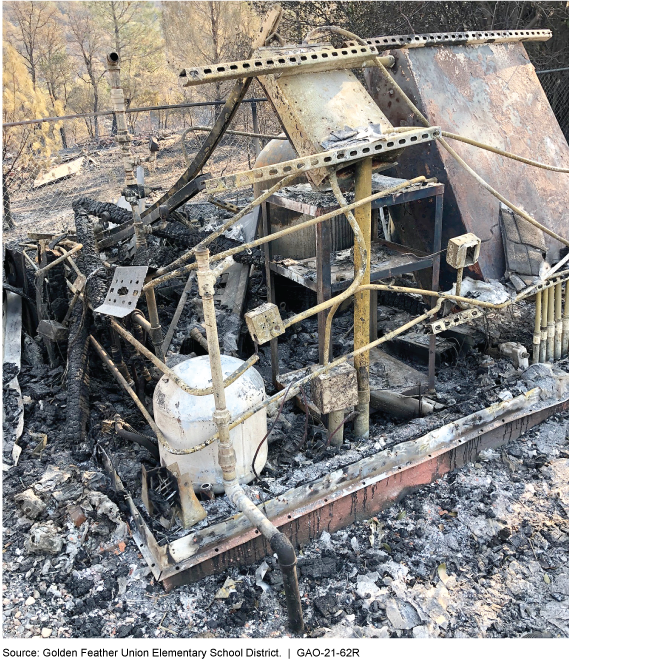Disaster Recovery: COVID-19 Pandemic Intensifies Disaster Recovery Challenges for K-12 Schools
Fast Facts
Since 2017, more than 260 major disasters were declared—many of which disrupted K-12 schools and students' lives. Now, these challenges are compounded by the COVID-19 pandemic.
Local education officials in disaster-affected areas said the pandemic exacerbated mental health issues, delayed recovery projects, and more. Officials said student mental health was a top priority but services needed to treat disaster-related issues were not readily available.
The U.S. Department of Education awarded nearly $1.4 billion to help schools recover from these disasters. Some local officials said the pandemic made it difficult to use these funds.
This school water system was damaged in the Camp Fire in Northern California in 2018.

Highlights
What GAO Found
Local education officials in natural disaster-affected areas told us the Coronavirus Disease 2019 (COVID-19) pandemic has exacerbated mental health issues and contributed to lost instructional time, staff burnout, delays in recovery projects, and financial strain in their communities. These officials explained that after the natural disaster, restoring students' mental health was a top priority. Many local education officials said that the services needed to treat trauma and other disaster-related mental health issues were not readily available in their areas, and some noted that providing mental health services has been especially difficult during the pandemic. For example, one official said that because half of her students live in poverty, they usually access mental health services through the school, and were cut off from those services during the pandemic.
Some local education officials said they were also particularly worried about the effects of the pandemic on their low-income and other at-risk students, noting that these students are especially vulnerable to learning loss. The COVID-19 pandemic has also affected districts by slowing progress on some disaster recovery projects. For example, an official in a district affected by wildfire said that an effort to restore running water to damaged school buildings was delayed due the pandemic.
The U.S. Department of Education (Education) supported school recovery efforts by awarding nearly $1.4 billion to assist schools in over 30 states and U.S. territories with recovery from presidentially-declared major disasters occurring between 2017 and 2019, although some local education officials reported difficulty in using these grant funds during the pandemic. Education provided this funding through the Immediate Aid to Restart School Operations (Restart) and the Project School Emergency Response to Violence grant programs, among others. Local education officials from several districts and counties said that they are using or planning to use Education disaster grants to provide mental health services to students and cover other costs associated with re-opening, such as additional transportation services, but that during the pandemic this was sometimes challenging. For example, officials in two counties said that timeframes for using Restart funds, which expire after 2 years, were too short for long-term recovery needs such as mental health services, particularly with the compounding effects of the pandemic.
Education officials said that grantees may request waivers to extend the end dates of these grants and that as of October 2020, no Restart grantees who experienced a 2018 disaster had done so. With regard to oversight, Education officials said they paused on-site monitoring efforts for recent disaster grants as a result of the pandemic, but have continued to hold quarterly phone calls with Restart grantees. These grantees have noted some challenges related to the grant program but have not discussed specific technical assistance needs, according to Education officials.
Why GAO Did This Study
More than 260 presidentially-declared major disasters have occurred since 2017, affecting every state and several U.S. territories, according to the Federal Emergency Management Agency (FEMA). Many of these natural disasters have had devastating effects, including rendering K-12 school facilities unusable for lengthy periods of time. These schools are now experiencing the compounding challenge of recovering from natural disasters while managing effects of the COVID-19 pandemic. Social distancing practices and building closures are meant to keep staff and students safe, but may also complicate recovery efforts for disaster-affected districts.
The Additional Supplemental Appropriations for Disaster Relief Act of 2019 provided funds for GAO to audit issues related to presidentially-declared major disasters that occurred in 2018. We reviewed (1) how the COVID-19 pandemic has affected schools recovering from recent natural disasters; and (2) support Education has provided to help school recover from recent natural disasters and how the COVID-19 pandemic has affected schools' use of these resources.
We interviewed 29 local education officials representing over 50 school districts in California, Commonwealth of the Northern Mariana Islands, Florida, and Hawaii, which were selected because they were affected by a diverse set of major natural disasters in 2018 that occurred in a mix of populated and less-populated areas. In addition, through a national school superintendents association, we convened a discussion group of superintendents who have experienced natural disasters and mentor other affected districts. Finally, we reviewed federal guidance and interviewed Education officials.
For more information, contact Jacqueline M. Nowicki at (617) 788-0580 or nowickij@gao.gov.
